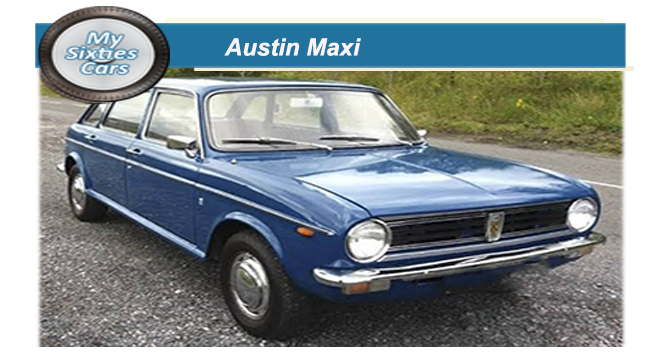
The Maxi was the last model released by Austin during the Sixties. In a way, the release of the Maxi caused a number of firsts for British Leyland, the new owners of BMC, in that it was the last model from Austin to carry the Sir Alex Issigonis stamp.
What was a breakthrough in terms of design and practicality was that the Maxi was a hatchback model, the first ever to be released by BMC.
N ot only was it Austin and British Leyland's first-ever hatchback, but it also featured a new breed of engine, the overhead-camshaft 1485cc E-Series, and a new five-speed gearbox.
ot only was it Austin and British Leyland's first-ever hatchback, but it also featured a new breed of engine, the overhead-camshaft 1485cc E-Series, and a new five-speed gearbox.
Regarding range planning, the Austin Maxi fitted very nicely into a niche between the 1300 and the 1800.
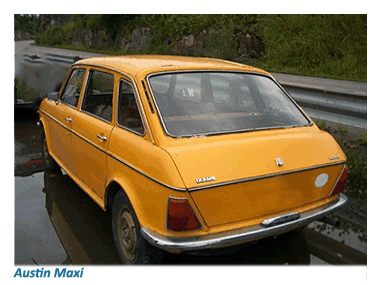 Reportedly British Leyland had been planning the release of the Maxi for some time, so that they could finally phase out the Farina designed models released at the end of the Fifties.
Reportedly British Leyland had been planning the release of the Maxi for some time, so that they could finally phase out the Farina designed models released at the end of the Fifties.
The reason for the delay in announcing replacements for the Farinas was that British Leyland had learned from the mistakes made by the BMC management team and held back on the Maxis release until new cars before reasonable stocks were available.
The Maxi came fitted with a new single overhead camshaft (OMC) 1485-cc "undersquare" engine, capable of generating 75 bhp net.
This new engine was one of the first significant projects embarked upon by British Leyland, with a budget of several million pounds.
Intended to serve the needs of British Leyland for at least the next ten years, the new and very compact six-cylinder engine was designed to suit some similar transverse mounting engine scenarios using the same tooling.
![]()
The new engine had a single SU HS6 carburettor, and featured an unusual head design, with valves inclined away from each other, producing a long inlet and short exhaust tract. British Leyland placed particular emphasis on the ease of maintenance and service anticipated with the overhead camshaft installation.
T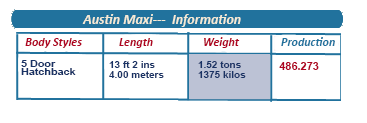 he Maxis engine was matched up to an all-new five-speed transmission located in a strong alloy sump,
he Maxis engine was matched up to an all-new five-speed transmission located in a strong alloy sump,
Engine, gearbox and Hydrolastic front suspension were all mounted in a conventional sub-frame.
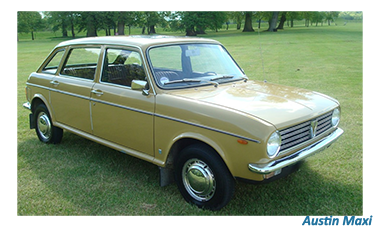 This, in turn, was mounted on an incredibly strong unitary construction bodyshell, owing much to the 1800 in looks and construction.
This, in turn, was mounted on an incredibly strong unitary construction bodyshell, owing much to the 1800 in looks and construction.
The Maxi's hydrolastic suspension was based upon that used in the Austin 3 Litre- was used, with separate pitch damping and individual wheel control.
Internally, the Maxi offered reclining front seats forming a reasonably comfortable bed, combined with a folding rear seat squab to give valuable freight space, accessible through the full-width tailgate.
Once again, the Maxi trim was spartan, with no luxurious features, very much in keeping with the car's workhorse image.
![]()
While the Maxi was a first-class example of a dual purpose vehicle, it came with a myriad of problems.
The UK public had gotten used to the cars being more comfortable making the Maxi less attractive than some of its competitors, in the same niche.
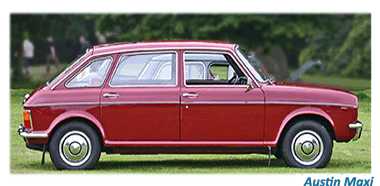 On the other hand, the hatchback made the Maxi very attractive to fleet operators and car hire companies, but to the man in the street, it was less appealing.
On the other hand, the hatchback made the Maxi very attractive to fleet operators and car hire companies, but to the man in the street, it was less appealing.
By the end of the Sixties and going into the Seventies, it was becoming apparent to all concerned that the British Leyland (BLMC) was having more than their share of problems, gradually affected by deteriorating labour relationships which brought with it hapless quality control.
The Maxi remained in production through the Seventies, despite never being the vehicle of choice for the vast majority of the UK car buying public.







